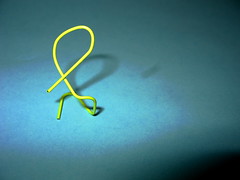Young children love races, and they are sure to love the vibrant energy of this month's Clip & Save Art Print. Ask students to describe where they would be standing if they were actually at this race (Edouard Manet wanted the viewer to feel as if he were standing on the track, as to increase the sense of action and speed).
To help the children understand this direct perspective, take them outside or to the school gym for a foot race. Place students in two equal groups. Have one group line up as if on a starting line. Place the other group opposite them, approximately 50 feet away.
Have one group go first, running toward the other, stopping at a safe distance to avoid any injuries. Then have the second group race toward the first. Take photographs of each group in motion to post in class at a later time.
In another class period, share the photos with the class and give students a chance to draw the race with the same perspective that Manet employed in his painting. Give students crayons or colored pencils to finish their drawings.
ELEMENTARY
Share the Art Print with students and explain that Edouard Manet wanted to create a picture that captured the speed and motion of a horse race. Point out that his loose brushwork makes everything in the composition appear blurry, which gives the illusion of movement. (Challenge students to identify the areas of the picture that are not in motion).
Give students digital cameras and take them outside to the playground or to the gym. Let students engage in a variety of physical activities: running, shooting baskets, hitting tennis balls and so on. Students should spend time photographing one another in action.
Upload students' photographs onto a class Web page, and give them time to analyze the images and choose one on which to base a drawing. Print out each student's selection and instruct them to do a pencil drawing of the scene. After sketches are complete, students can use chalk pastels to loosely lay in color, trying to create the "blurred" brushwork of Manet's horse race.
MIDDLE SCHOOL
Share the Art Print with students. Ask them to study the composition and explain how the artist creates the illusion of movement with paint. Point out that the "painterly," or loose, brush style creates a blurriness that produces a sense of movement to the human eye.
Give students time to sketch a scene that incorporates movement (a person or people in motion, a windy day, race cars speeding down a track). After students determine a final design on paper, have them lightly pencil in their design on canvas. Before they apply paint, give them time to practice their loose brushwork. Display the paintings with the Art Print.
HIGH SCHOOL
Edouard Manet is widely considered by art historians to be one of the few artists of the 19th century to have laid the groundwork for what would come to be called Modernism.
Share the Art Print with students and share the biographical information found on the reverse of the print, in the Art Notes. Challenge them to answer the following question: Why has Manet been called a father of Modernism?
Students can work individually or in small groups, but all should answer the question via research that they will present to the class. Students can also create an original artwork incorporating aspects of Edouard Manet's style.
ONLINE TEACHING RESOURCES
* www.edouardmanet.com
* www.manetedouard.org
* www.kentuckyderby.com/news/videos/kentucky-derby137-replay
* www.olympic.org/athletics
* www.arthistoryresources.net/modernism/roots.html
* www.youtube.com/watch?v=UrRUDS1xbNs&feature=related
Source Citation
"The races at Longchamp, Edouard Manet." Arts & Activities Apr. 2012: 19. Fine Arts and Music Collection. Web. 24 Apr. 2012.
Document URL
http://go.galegroup.com/ps/i.do?id=GALE%7CA283833634&v=2.1&u=22054_acld&it=r&p=PPFA&sw=w
Gale Document Number: GALE|A283833634


No comments:
Post a Comment